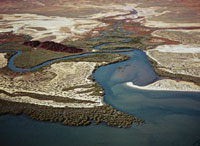|
Biological wealth of the region
Australia's North West Shelf seabed habitats support some of the greatest recorded marine biodiversity in the world
Marine ecosystems that meet arid landscapes have distinctive characteristics and sensitivities Australia’s North West Shelf is ecologically diverse and complex. Its seabed habitats support some of the greatest recorded marine biodiversity in the world; including a remarkable array of marine fauna including tropical fish, hard and soft corals, sponges, crustaceans and turtles. It has diverse and productive inshore reefs and some of the world’s finest examples of tropical arid-zone mangroves. Marine ecosystems that meet arid landscapes — such as the North West’s Pilbara region — have distinctive characteristics and sensitivities. But unlike their tropical counterparts, they had received relatively little study prior to the NWSJEMS. It has diverse and productive inshore reefs and some of the world’s finest examples of tropical arid-zone mangroves. Ningaloo Marine Park, at the southern end of the Shelf, is home to endangered dugongs, migratory whales and giant whale sharks. Ningaloo attracts many thousands of tourists each year and new tourism facilities are being developed to meet increasing demand. Marine parks have also been declared for the Dampier Archipelago and the Monte Bello Islands. Strong links exist within and between the region’s shallow-water tropical marine systems. Coral larvae can be transported by ocean currents to help maintain ‘downstream’ coral reefs. Mangrove-lined shores prevent coastal erosion and consequent silting of adjacent reefs. These mangroves provide nurseries for some juveniles of marine species that live around reefs as adults. Coral reefs in turn protect shores from violent wave action. Because of these links, any local damage caused to one part of an ecosystem can have flow-on effects elsewhere. |

